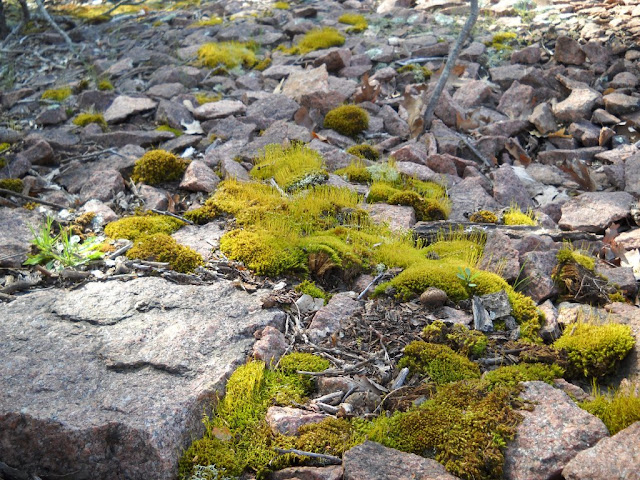I went home last weekend, and I spent part of that time sightseeing. One of the places I visited was Elephant Rocks State Park, a sizeable collection of gigantic granite rocks. The site used to be a granite quarry, so there's a lot of history there. I've been to Elephant Rocks scores of times, though, so I was more interested in the plants. Oh, who am I kidding? Plants are always more interesting. I took a lot of pictures, so there will be a few posts about this. Let's get started!
The first plant at the park that really caught my eye was one you don't often think about seeing in Missouri: the prickly pear cactus (Opuntia genus, possibly humifusa since it's so far east).
While a part of me wanted to harvest a pad or two from this cluster to try to eat, I decided against it. One shouldn't disturb nature when possible, and besides, I didn't have any gloves, and glochids (the tiny spines that lodge in and irritate your skin - the brown furry bits in the following picture) aren't fun. For a cactus, this plant has seemingly survived our wacky winter and spring very well.
I definitely want some edible Opuntia someday. Eating these plants to me is a symbol of man's mastery of nature (read: I can eat things with big sharp spines!). Also, regarding the picture below, isn't it surreal to see moss and cactus in the same frame?
Speaking of the moss, that's what next captured my attention, so I captured some views of it. Moss is really cool (most of their tissues are haploid, meaning they only have one set of chromosomes. The only haploid human tissues are sperm and egg cells), so I usually stop to look at it, but some of the moss I saw at Elephant Rocks was reproducing. This is a phenomenon that only happens in really wet areas (thank you terrible flooding rains!), and it's one that I only recently learned about. That's why seeing cactus and moss in the same spot is odd to me: one needs dry climates, and the other needs very wet climates.
See those little stalks poking up from the moss? Those aren't stems--they're sporophytic (read: diploid, meaning they have two sets of chromosomes) stalks that release spores out of the pointed structures at their tips. The spores are haploid, and they grow into the fuzzy mats of moss you normally see.
The reason moss can only reproduce when its environs are wet is that moss sperm is "swimming sperm," just like in ferns. This means that the sperm cells can't move on their own; instead, they must be carried to and fro in water. Moss can produce all the sperm and eggs it wants when it's dry out, but they will never meet and produce these sporophyte stalks that spit out the next generation of moss.
Before long, there's going to be a lot of moss in this spot!
You can actually see the effects of swimming sperm here. The portions of this clump of moss that aren't in shadow aren't reproducing because water evaporates more quickly from them. The portions that are more protected from the sun's rays are able to reproduce. I didn't think of that when I took this picture. I just thought it was odd that only some of it was producing the sporophyte stalks. Now I'm glad I noticed.
I hope you learned a bit about plants today. Do you still find moss adorable, even though most of its cells are technically sex cells? Are you surprised to see cactus in Missouri? (I've never seen any that big here before.)
Next post: more from Elephant Rocks!










No comments:
Post a Comment